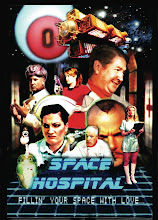 |
| A psychedelic rainbow of color amidst the destruction |
THE FICTION:
On Monday, we released episode 2.5, “Curse of the Draco” [Part 2], which you can watch on YouTube or in Koldcast’s high-definition player.
Previously on Space Hospital, Lyndsay revealed to Nurse Ratknee that she was the fused remains of Ratknee’s half-robot son and galactic tennis star Lyndsay Austin. Meanwhile, Draconoids bombarded the hospital, which was left vulnerable during software updates.
In Curse of the Draco [Part 2], Dr. Drake administers an ink blot test to Dr. Goode, concluding that his alien fixation requires brain surgery. Nurse Barbara, still angry that Goode stood her up at the altar, flaunts her pregnancy to Goode, bragging that Drake is the father. The software update complete, Lyndsay and Nurse Ratknee stand by as C.R.O.N.O.S. (Central Repository of Nominal Operating Systems) boots up and asserts its authority over the hospital. “Lyndsay, meet your daddy,” Ratknee says. Within seconds all systems are back on line, and Space Hospital blasts the Draconoids with such a force that the hospital is sent spinning back into a mysterious dark nebula.
THE “SCIENCE:”
It’s been modern man’s dream to create technologies that do our bidding and make our lives easier and safer. And in a spirit of camaraderie with technology, humans have happily submitted to an increasing level of surveillance: computers in our cars that summon emergency services after a crash; image recognition software in cameras in public spaces to match facial features to those of known criminals; and medical surveillance services that monitor the elderly 24/7 and even provide a caseworker who virtually “sits down” with them for a meal.
But, on the other hand, the GPS embedded in our phones that allows us to become the “mayor” of our favorite Quiznos also enables advertisers to profile us, sell to us and re-sell that information to other companies. And the trade-off for the all the freedom and access to information the internet provides us is that our interests, desires and personal lives are turned into a commodity by those wily entrepreneurs who saw a massive new market opportunity in doing so.
 |
| "You're not going anywhere, sweetheart." |
With diseases to cure, social ills to heal, a universe to explore, a partnership with technology is too intoxicating to resist and, yet, even still we wonder what the dark downside is to such a transfer of power.










